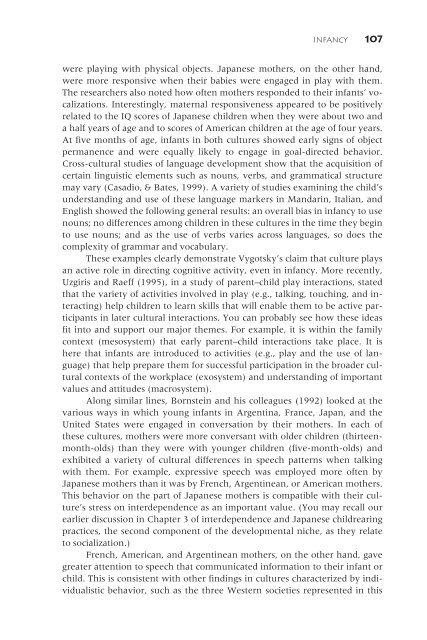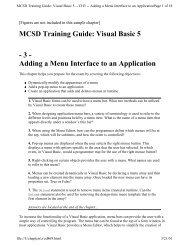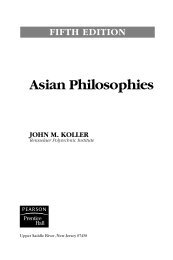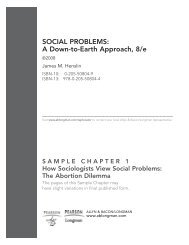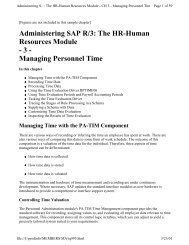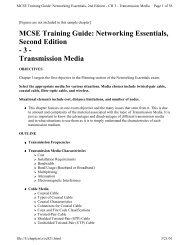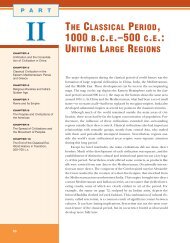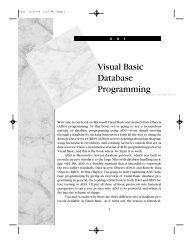CULTURE, language, AND COGNITION
CULTURE, language, AND COGNITION
CULTURE, language, AND COGNITION
You also want an ePaper? Increase the reach of your titles
YUMPU automatically turns print PDFs into web optimized ePapers that Google loves.
GA305c05.qxd 4/30/2004 11:26 AM Page 107<br />
infancy 107<br />
were playing with physical objects. Japanese mothers, on the other hand,<br />
were more responsive when their babies were engaged in play with them.<br />
The researchers also noted how often mothers responded to their infants’ vocalizations.<br />
Interestingly, maternal responsiveness appeared to be positively<br />
related to the IQ scores of Japanese children when they were about two and<br />
a half years of age and to scores of American children at the age of four years.<br />
At five months of age, infants in both cultures showed early signs of object<br />
permanence and were equally likely to engage in goal-directed behavior.<br />
Cross-cultural studies of <strong>language</strong> development show that the acquisition of<br />
certain linguistic elements such as nouns, verbs, and grammatical structure<br />
may vary (Casadio, & Bates, 1999). A variety of studies examining the child’s<br />
understanding and use of these <strong>language</strong> markers in Mandarin, Italian, and<br />
English showed the following general results: an overall bias in infancy to use<br />
nouns; no differences among children in these cultures in the time they begin<br />
to use nouns; and as the use of verbs varies across <strong>language</strong>s, so does the<br />
complexity of grammar and vocabulary.<br />
These examples clearly demonstrate Vygotsky’s claim that culture plays<br />
an active role in directing cognitive activity, even in infancy. More recently,<br />
Uzgiris and Raeff (1995), in a study of parent–child play interactions, stated<br />
that the variety of activities involved in play (e.g., talking, touching, and interacting)<br />
help children to learn skills that will enable them to be active participants<br />
in later cultural interactions. You can probably see how these ideas<br />
fit into and support our major themes. For example, it is within the family<br />
context (mesosystem) that early parent–child interactions take place. It is<br />
here that infants are introduced to activities (e.g., play and the use of <strong>language</strong>)<br />
that help prepare them for successful participation in the broader cultural<br />
contexts of the workplace (exosystem) and understanding of important<br />
values and attitudes (macrosystem).<br />
Along similar lines, Bornstein and his colleagues (1992) looked at the<br />
various ways in which young infants in Argentina, France, Japan, and the<br />
United States were engaged in conversation by their mothers. In each of<br />
these cultures, mothers were more conversant with older children (thirteenmonth-olds)<br />
than they were with younger children (five-month-olds) and<br />
exhibited a variety of cultural differences in speech patterns when talking<br />
with them. For example, expressive speech was employed more often by<br />
Japanese mothers than it was by French, Argentinean, or American mothers.<br />
This behavior on the part of Japanese mothers is compatible with their culture’s<br />
stress on interdependence as an important value. (You may recall our<br />
earlier discussion in Chapter 3 of interdependence and Japanese childrearing<br />
practices, the second component of the developmental niche, as they relate<br />
to socialization.)<br />
French, American, and Argentinean mothers, on the other hand, gave<br />
greater attention to speech that communicated information to their infant or<br />
child. This is consistent with other findings in cultures characterized by individualistic<br />
behavior, such as the three Western societies represented in this


